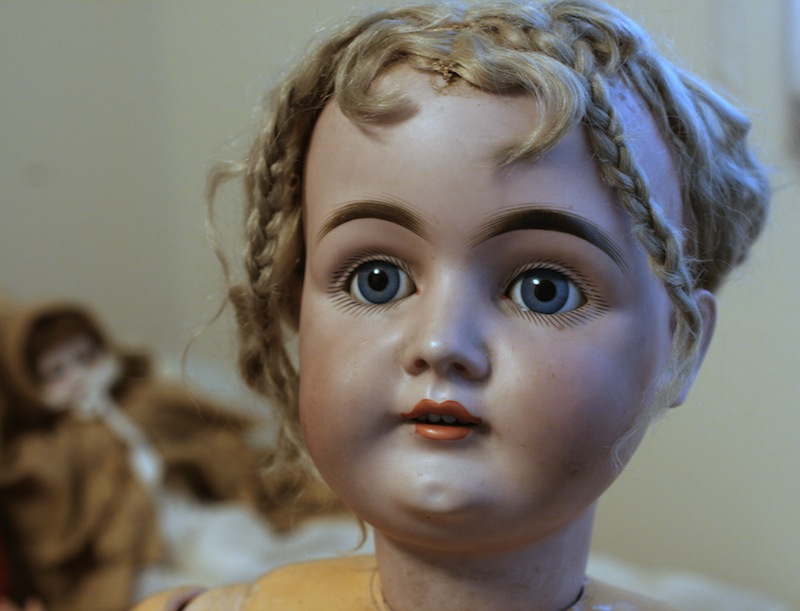You have no items in your cart. Want to get some nice things?
Go shopping I’m going to tell you a ghost story.
I’m going to tell you a ghost story.
I’ve been morbidly fascinated by the supernatural for most of my life. When I was a child I had a terrifying book called The Oxford Book of Nasty Endings. I would read one story from it, have vivid nightmares all week about werewolves coming for me through the ceiling, recover, and promptly read another one. My friends and I also spent a lot of time telling each other ghost stories—though now that I think about it, what we were really doing was telling each other variations of the same one, over and over again. It always went something like this:
There was a little girl who was given a doll. Why she got the doll was always left in some doubt, but probably had more to do with her being a little girl than her actually wanting the doll (this tends to happen if you are a little girl). Anyway, she was given this doll by someone who had probably found it up in their attic, or in a junk shop, because it was one of those horrible china dolls with staring eyes, a dead white face and bright red lips. In real life you would take one look at it and know it was bad news, but this is a ghost story, so nobody did.
The little girl, who was not stupid, hated the doll, and so before she went to bed that night she hid it at the very far end of her room with its face to the wall. But when she woke up the next morning the doll had moved. It was now propped up on the table next to the window, and worst of all it was looking straight at her. The little girl very sensibly told her mother that the doll was alive and trying to kill her, but her mother was both an adult and a character in a ghost story, so she ignored her. Every night the little girl hid the doll, and every morning she woke up to find the doll sitting on a shelf, or a chair, or the rug, coming closer and closer and closer to her bed.
She left the doll in the sitting room, and the next morning it was on her bookshelf. She buried the doll in the garden, and when she woke up the next day, it was staring at her from the bedside table. And then one morning her mother came into the little girl’s room and found her lying in her bed, quite dead. And sitting on the pillow next to her was the doll, with a little red smile on its white china face.
That’s the basic story, anyway. I never heard it quite the same way twice. In my Book of Nasty Endings there’s a somewhat classier version with a faun statue, and I’ve seen it told with angry vases, menacing pictures and even (I can’t believe this frightened me at the time) a giant vengeful teddy bear. I think I even remember reading one where the evil object was a comfort blanket. But the idea that all these versions have in common is this: your possessions are alive, and they’re coming for you.
Of course, it’s a ridiculous thought, but it’s one that people just can’t leave alone. Because it’s completely insane and yet… we do care about the objects we own. We clean them, we mend them, we polish them and we can really love them. Anyone who thinks this isn’t true has never been a child with a lost toy.
But while we know that the love we give our pets is returned (unless they’re cats), we can’t ever tell how our possessions feel about their owners. Abuse your pets and they’ll hate you (if you’re ever tempted to do this please read Edgar Allen Poe’s The Black Cat), but even if you’re extremely nice to your ornaments (especially the ones with faces), you can never be entirely sure that they won’t just turn around one day and eat your soul.
That’s really what poltergeists are, after all—stories about people being beaten up by their furniture. Ghosts seem to have a peculiar fondness for possessing the things you own or (even more ominously) the things you find: a mirror, a ring, a dress. M. R. James’s story, “Oh, Whistle And I’ll Come To You, My Lad” is a nice lesson in why you should never pick up anything you see lying about on the ground—you just don’t know where it’s been. And what about all those stories in which sofas come to life and inhale their occupants? Even your home decor’s not safe; if you don’t believe me, read The Yellow Wallpaper by Charlotte Perkins Gilman. Once you start thinking about it, you realise that evil things are almost as much of a ghost story trope as evil children.
It’s interesting to notice that people often use the same sort of images when they’re complaining about our materialistic culture. Marx illustrates his theory of commodification (I’m so sorry, I had to read it last week) with a table that gets up and dances—possession if ever I heard it. There’s also a great line in a William Carlos Williams’ poem that goes “In my life the furniture eats me.” It’s probably about materialism and our inability to form human relationships (with Williams, and I mean this in the most appreciative way, it’s often difficult to tell), but I choose to read it as one of the shortest ghost stories of all time.
Things, therefore, are scary. You never quite know what they’re capable of. They seem quiet and innocent now, but ignore them for a moment and before you know it they’ll be running through the corridors biting at your ankles like Terry Pratchett’s Luggage. I’m not suggesting you purge your house in time for Halloween, or anything, but… you never know. It might be worth it.

About Robin Stevens
Robin started out writing literary features for Litro and joined the team in November 2012. She is from Oxford by way of California, and she recently completed an English Literature MA at King's College, London. Her dissertation was on crime fiction, so she can now officially refer to herself as an expert in murder (she's not sure whether she should be proud of that). Robin reviews books for The Bookbag and on her own personal blog, redbreastedbird.blogspot.co.uk. She also writes children's novels. Luckily, she believes that you can never have too many books in your life.


My parents (or not, if they and your ghost story are to be believed) used to rearrange my dolls while I was sleeping, to make them look as though they were having a tea party on the floor by my bed. I would wake up and there they would be, cups held in mid air as if my waking had frozen them mid-party.
I think they thought it would charm me and I’d be delighted by the idea they came to life and played at night. They forgot that I was a little girl and that I knew the story and so were confused when I threw them all out of the window. It also led to two years of only being able to sleep if all of my body, including my head, was under the quilt. I made a little air-hole. What is it about being in bed, especially being in bed, under the quilt, with arms and legs not hanging over, that renders you safe?
And would it still work now if my dressing table decided to try and batter me in the night?